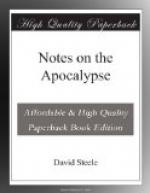Verses 1-3.—“After these things,” contained in the three preceding chapters, the glorious vision of the mediatorial person, and the writing and sending of the seven epistles; there seems to have intervened a pause. While John was in expectation of farther discoveries of “things which were to be thereafter,” “behold, a door was opened in heaven,” the place of Jehovah’s special residence. But as this “heaven” is sometimes the theatre of war, (ch. xii. 7,) of course it is not to be taken literally. As a symbol it generally signifies organized society, over which the Most High presides. The “door opened” afforded the means to John of seeing the objects within. The “voice as of a trumpet,” which arrested his attention, was that of Christ,—the “voice of the Lord, full of majesty.” (Ps. xxix. 4; ch. i. 10, 11.) John was in his own apprehension, like Paul, “caught up into the third heaven,” that he might behold in glorious succession “things which must be hereafter.” Why must they be? Simply because such was the “purpose of Him who worketh all things after the counsel of his own will; who is wonderful in counsel and excellent in working; whose counsel stands, and who doeth all his pleasure.” (Eph. i. 11.) Can a rational creature work without a plan? And shall mortal man be more rational than his Maker? The objects which were presented to John are not to be understood as material objects. It was requisite that he should be “in the Spirit,” before he could see them. The exercise of his bodily senses, the organs of sensation, must be suspended, that he might have a perception of the objects presented in vision. As the “spirits of just men made perfect” in glory, in a disembodied state, are still conscious and active; so are we warranted to conceive of souls yet in the body as being in a state analagous,—falling into a trance. (Acts x. 10.) The first object seen by John was a “throne set in heaven,” the emblem of sovereignty. “One sat on the throne,” who cannot be described, only in an obscure manner by comparison, being “the invisible God, whom no eye hath seen, nor can see.” Yet we know with certainty it is the person of the Father, because he is in the next chapter plainly distinguished from “the Lamb.” Seated on the throne,—and “in the throne he is greater than the Mediator.” A relation between these divine persons was shadowed forth in Egypt between Pharaoh and Joseph. (Gen. xli. 40.) Occupying the throne of the universe, the Father sustains the majesty of the Godhead, and represents the persons of the adorable Trinity; for the idea is equally unscriptural and absurd, that either person appears or acts (ad extra) in absolute or essential character. (Is. xlii. 1; John x. 18; xiv. 31.) He that “sat, was ... like a jasper and a sardine stone,”—not like any human form, but in allusion, perhaps, to the Shekinah or visible glory above the mercy-seat in the most holy place, he appeared in the essential purity or holiness of




